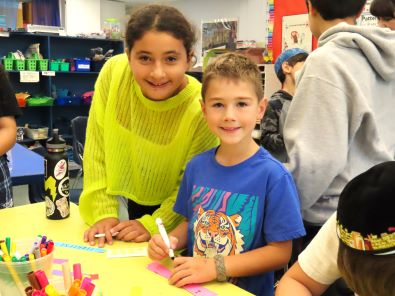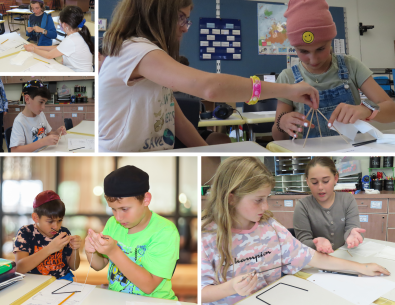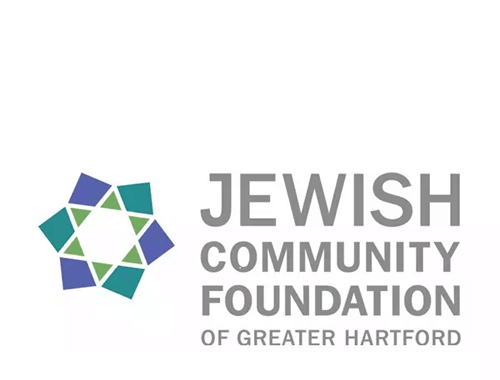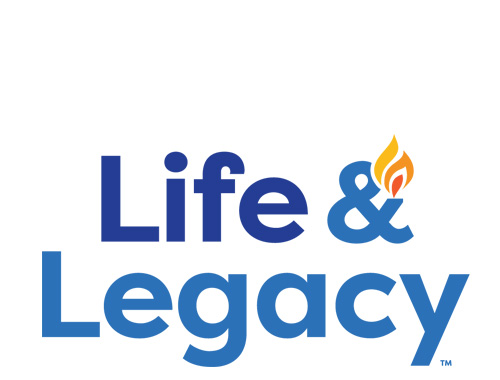Schechter Shavua: October 6, 2023
Shevet Groups Work Together to Make a Festive Sukkot
 Our multiage Shevet program has resumed in time to celebrate Sukkot! This week, students gathered in their Shevet groups from last year, now joined by many new students. Together, they played introduction games so that everyone learned each other’s names. Students discussed the holiday of Sukkot: its significance, the identities of the four species, and many favorite Sukkot customs. Each Shevet made part of a paper chain that connected to all other pieces of the chain. This chain decorated our school hallways throughout the week of Sukkot. Finally, each Shevet decorated a Magen David mobile that hung inside our school’s beautiful Sukkah.
Our multiage Shevet program has resumed in time to celebrate Sukkot! This week, students gathered in their Shevet groups from last year, now joined by many new students. Together, they played introduction games so that everyone learned each other’s names. Students discussed the holiday of Sukkot: its significance, the identities of the four species, and many favorite Sukkot customs. Each Shevet made part of a paper chain that connected to all other pieces of the chain. This chain decorated our school hallways throughout the week of Sukkot. Finally, each Shevet decorated a Magen David mobile that hung inside our school’s beautiful Sukkah.
Click HEREto see photos of the Shevet Sukkot program.
There’s a Wolf in Your Sukkah!
 When the wolf from the story of the Three Little Pigs visits Greater Hartford, Schechter’s fifth and sixth graders spring into action! In MakerSpace class, students are told that the wolf wants to huff and puff and blow the sukkah down…and it is their job to foil the wolf's plans! Each group of students received 10 tissues, one meter of string, four small straws, four toothpicks, and four small craft sticks; they were tasked with collaborating to build a sukkah that would withstand the wolf's blustery attempts! Upon completion of their miniature sukkahs, MakerSpace teacher Laurie Stanfield tested their construction and design with a hair dryer to assess its sturdiness. Groups learned from structural flaws and were able to tweak their designs to make them more effective. Learning through trial and error is an effective way to gain a deeper understanding of concepts! Kol hakavod , and chag sukkot sameach!
When the wolf from the story of the Three Little Pigs visits Greater Hartford, Schechter’s fifth and sixth graders spring into action! In MakerSpace class, students are told that the wolf wants to huff and puff and blow the sukkah down…and it is their job to foil the wolf's plans! Each group of students received 10 tissues, one meter of string, four small straws, four toothpicks, and four small craft sticks; they were tasked with collaborating to build a sukkah that would withstand the wolf's blustery attempts! Upon completion of their miniature sukkahs, MakerSpace teacher Laurie Stanfield tested their construction and design with a hair dryer to assess its sturdiness. Groups learned from structural flaws and were able to tweak their designs to make them more effective. Learning through trial and error is an effective way to gain a deeper understanding of concepts! Kol hakavod , and chag sukkot sameach!
Click HEREto see a video of the MakerSpace Sukkah Challenge!
Schechter Families Enjoy Sukkot Together
 The Schechter Parent Association (PA) hosted two festive evenings in our beautiful Joshua Allon Silver Memorial Sukkah this week. Pizza in the Hut brought together families with children of all ages to enjoy a communal craft project, yummy non-alcoholic mixed drinks, and delicious pizza from the Crown Market. Everyone was excited to contribute to the six different Jewish-themed banners that will become beautiful decorations around our school. Subjects include a torah, magen david, holiday/shabbat candles, and sukkot theme. We can’t wait to show off the finished products!
The Schechter Parent Association (PA) hosted two festive evenings in our beautiful Joshua Allon Silver Memorial Sukkah this week. Pizza in the Hut brought together families with children of all ages to enjoy a communal craft project, yummy non-alcoholic mixed drinks, and delicious pizza from the Crown Market. Everyone was excited to contribute to the six different Jewish-themed banners that will become beautiful decorations around our school. Subjects include a torah, magen david, holiday/shabbat candles, and sukkot theme. We can’t wait to show off the finished products!
Many thanks to Nevatimstudent Paige Ferenc (gr. 5) and parent Rachel Glantz for submitting wonderful photos of both events!
Click HEREto see photos from the whole week of Sukkot at Schechter.
Parashat Vezot Haberakhah/Simchat Torah—The lesson of Moshe’s Hidden Grave
 Tens of thousands of Jews descended upon Uman, a city in Ukraine, for Rosh Hashanah. Why? They flew from Israel and around the world to visit the grave of their rebbe, Nahman of Bratslov.
Tens of thousands of Jews descended upon Uman, a city in Ukraine, for Rosh Hashanah. Why? They flew from Israel and around the world to visit the grave of their rebbe, Nahman of Bratslov.
Many graves in the Jewish world are sought out by large numbers of visitors, and we understand why: from a natural desire to show respect to teachers, rabbis, and family members. We want to honor the memory of those we knew, or wish we had known. We may hope that their souls, gone from this earth, will somehow be aware of our continued devotion to them and to their values. By visiting a grave, we lovingly proclaim, “Your memory lives on.”
Moshe generally serves as a role model; according to the Torah, his relationship with God was stronger and more direct than anyone else’s before or since. If visiting the graves of the righteous were truly a Jewish imperative, then Moshe’s grave would surely be a prime pilgrimage destination. And yet, what does the Torah tell us about his grave? Velo yada ish et kevurato ad hayom hazeh; “To this day, no one knows the place of his burial.” We can’t go there; we just don’t know where it is. In fact, it seems that God deliberately kept the location hidden.
Why conceal the grave? One reason may have been to ensure that it wouldn’t be worshiped. How ironic it would be if the grave of the great monotheist were to become an object of idol worship!
But I think there’s another reason Moshe’s grave was kept hidden: to teach a lesson that the best way to honor his memory is to study Torah. That’s what Moshe stood for; that’s what we should do. For the same reason, we can save our airfare to Ukraine—instead, we can try to live with the audacious joy that Rav Nah man represents. In general, the best way to honor our loved ones’ memories is to do something in their honor: perform a mitzvah, or study some appropriate Torah.
May the memories of all those we have lost be blessings to us—blessings of Torah and ma’asim tovim, good deeds.
Have a wonderful Shemini Atzeret and Simchat Torah!
Rabbi Jonathan Berger
Head of School
Questions for the Shabbat table:
1. Can you think of any other reasons why Moses’s burial site might have been hidden?
2. Which losses do you most mourn—and what are some ways especially appropriate to them to keep their memory alive?
Solomon Schechter Day School
of Greater Hartford
26 Buena Vista Road
West Hartford, CT 06107
© Solomon Schechter Day School of Greater Hartford | Site design Knowles Kreative




